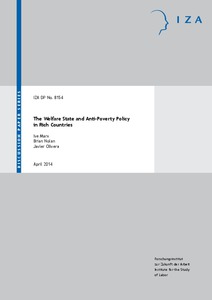The welfare state and anti-poverty policy in rich countries
"This paper is prepared as a chapter for the Handbook of Income Distribution, Volume 2 (edited by A. B. Atkinson and F. Bourguignon, Elsevier-North Holland, forthcoming). Like the other chapters in the volume (and its predecessor), the aim is to provide a comprehensive review of a particular ar...
| Main Authors: | , , |
|---|---|
| Institution: | ETUI-European Trade Union Institute |
| Format: | TEXT |
| Language: | English |
| Published: |
Bonn
2014
IZA |
| Subjects: | |
| Online Access: | https://www.labourline.org/KENTIKA-19119744124919379269-The-welfare-state-and-anti-pov.htm |
| Summary: | "This paper is prepared as a chapter for the Handbook of Income Distribution, Volume 2 (edited by A. B. Atkinson and F. Bourguignon, Elsevier-North Holland, forthcoming). Like the other chapters in the volume (and its predecessor), the aim is to provide a comprehensive review of a particular area of research. The aim of this chapter is to highlight some key aspects of recent economic research on the welfare state and anti-poverty policy in rich countries, and explore their implications. We begin with the conceptualisation and measurement of poverty, before sketching out some core features and approaches to the welfare state and anti-poverty policies. We then focus on the central plank of the modern welfare state's efforts to address poverty, namely social protection, discussing in turn the inactive working-age population, child income support, in-work poverty, and retirement and old-age pensions. After that we discuss social spending on other than cash transfers: the labour market, education, training and activation, and finally intergenerational transmission, childhood and neighbourhoods. We also discuss the welfare state and anti-poverty policy in the context of the economic crisis which began in 2007-8, and the implications for strategies aimed at combining economic growth and employment with making serious inroads into poverty. We conclude with highlighting directions for future research." |
|---|---|
| Physical Description: | 96 p. Digital |

